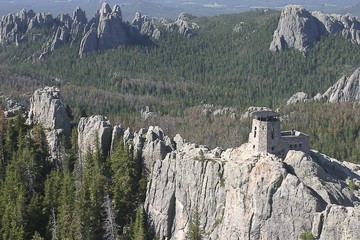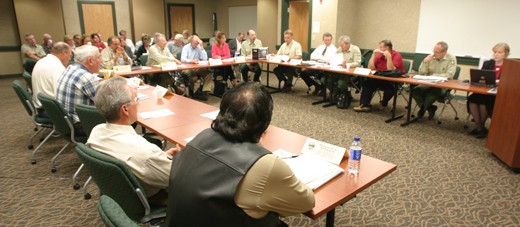John Rupe and I spent a day last week in Rapid City, South Dakota for a public meeting on the new planning rule, and also for a meeting of the Black Hills National Forest Advisory Board.
It was an interesting experience for me to start with the Science Forum, the National Roundtable in DC, then to Denver, then to Cheyenne for a meeting with government officials, then to public meetings there and in Rapid City. By listening to the similarities and differences expressed in the different kinds of places, I think I am starting to understand better the concerns which have led to place-based legislation. More on that later.
We heard the story from our Regional Forester about the White Mountain Forest having had an advisory committee until they were dispensed with by Jimmy Carter..whereupon they continued to meet and the forest supervisor continued to meet with them.
Checking for other forest advisory committees, I found this link to the 1977 Bend Bulletin describing the disbanding of the Advisory Boards. Maybe there is some more history as to why they were disbanded. It appears the forest supervisors and the public found them useful.. it’s a bit of a mystery (perhaps our more historically-oriented readers could help here.)
But one thing we did find out. There were a wide variety of interests at our planning rule roundtable in South Dakota, but there was general agreement that the Black Hills Advisory Board was useful. Here’s the webpage for the Advisory Board. The Board is not just about forest planning, though, it addresses the myriad of micro to megascale issues related to the forest.
One thought was, if you had advisory boards, that some forests have grown too large (through reorganizations) to be addressed in a meaningful way, and then you might need more than one advisory board per administrative unit.
What do you think? Should advisory committees for each forest be required or encouraged in the new rule?
P.S. There are many amazing photos of the Black Hills National Forest, as well as documents, audio and video, published here.


One example of a shadowy advisory board is the Wildland Fire Leadership Council, which seeks to establish and implement Federal wildfire policy. In the past, they’ve met in secrecy and allowed a few big eco-groups to sit with them while excluding the public. It appears their closed door sessions have been busted, and they are now toying with the idea of opening up a little bit more.
They are the ones responsible for pushing through the Let-Burn program and other practices that lessen aggressive fire suppression. With the numerous examples of escapes and HUGE increases in costs, their policies are dubious, at best. Turning what used to be a $3000 lightning fire into a $20,000,000 firestorm has chewed through Forest budgets and added many more millions to mitigation and rehabilitation measures. Clearly, their lack of compliance with NEPA analysis has led to a great many of these very serious issues. State and local fire agencies have officially pinpointed failed Federal fire policies as serious impacts on their public safety and economic viability. In the case of the Mill Flat fire in Utah, their Governor has demanded that the Feds pay the entire amount of suppression costs for a mishandled Let-Burn fire that burned homes and property, and forced evacuations.
I remain puzzled as to why we would think advisory boards useful for each national forest. This puzzle factors into a larger puzzle as to why we would think that the majority of policy-making ought to occur at that scale. I am not against advisory boards per se, but I do believe that too often they are dominated by development interests that may conflict with national interests for both conservation and environmental protection.
I have long advocated for adaptive management wherein policy would be made situationally as issues and concerns well up and can be considered at the best possible scale. As I’ve mentioned before, paraphrasing others, we should “look up a scale for both context and management.” That is, we should look to effect management at scales where it will do the most good and will not be subject to a mishmash of ad hoc policy calls — influenced too much by local political considerations. The same holds true for assessments and evaluation of management methods. Broader-scale and/or issue centric advisory boards may be a good idea, but again we must guard against the forest equivalent of political gerrymandering.
The rise in place-based bills, Forest advisory boards, and local based collaborative efforts are likely a result of the failure of broad scale policy to adequately address local concerns. Many of the neighbors and primary users of the National Forests have become alienated by the bureaucratic policy and regulations that have come down from the national level. I am not sure what the right answer is and there is probably more than one. The neighbors of the Forests generally have a better understanding of the local Forest and its special features and amenities.
Local advisory boards are a good thing and useful. They reconnect the local people to the Forest and let them be heard. I would think that an advisory board would be just that, and any of their recommendations would not be binding for management. They also give the people a feeling for the difficulties of managing the National Forest and complying with the national direction and policy. Collaboration is much easier at the local level than the national level. Just look at all of the national collaboration we’ve experienced lately, it ain’t happening folks. Special interests still hold sway, and the preservation groups seem to currently hold sway with the national policies and don’t want to lose that to locals who can agree on something. And yes locals do include conservationists and preservationist types.